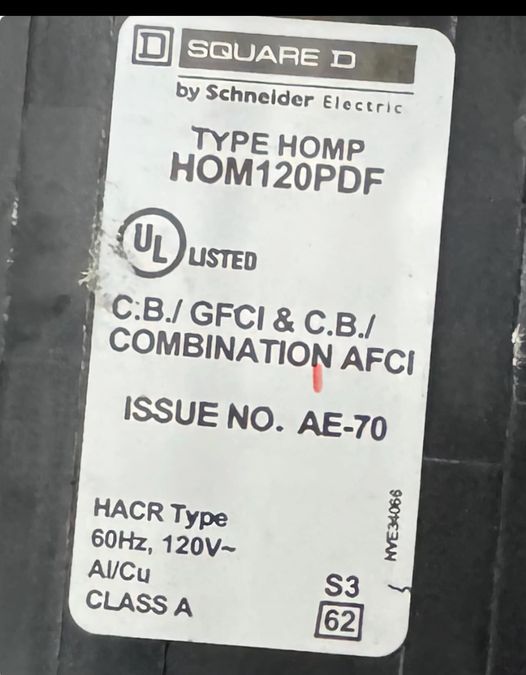Have you experienced nuisance tripping with multiple UPSs on a circuit with an AFCI breaker?
9 months ago
Last Updated: September 11, 2024
So, I’ve got this 15AMP breaker that just keeps tripping every few days. I’ve got my computer plugged into one UPS and my NVR plugged into another UPS. I’ve already checked for any loose wires and even swapped out the breaker, but it’s still acting up. This all started happening after I added the second UPS, so I thought maybe it was a faulty unit and switched it out. I’ve heard that having multiple UPS units on the same circuit can cause this kind of issue, especially with an AFCI breaker. Anyone else run into this problem before?

A FCI/AFCI breaker can trip for three reasons: too much current, a ground fault, or an arc fault. Unfortunately, this particular breaker model doesn’t give any indication of why it tripped, so we may need to do some process of elimination. How much current are the UPS’s pulling? Each piece of equipment should have a nameplate with a max current rating. If the total is more than 20A, it might just be too much current when everything is running at full capacity. To rule out a false AFCI trip, try installing a non-AFCI breaker temporarily to see if it trips. If it doesn’t, then I recommend reaching out to Square D about the nuisance tripping.
Can you split the two UPS into separate circuit breakers?
My guess is that the AFCI trips whenever a UPS switches to battery power or for voltage regulation.
Why does unplugging a load cause a FCI/AFCI to trip?
The AFCI breaker would detect the fast switching arcs
It’s that same arc that happens when you switch off a light or unplug an appliance. Arc faults don’t trip from normal arcs (short duration) usually seen in switches.
AFCIs are a complex piece of electronic equipment designed to identify arcing and deactivate power to the circuit, which helps prevent electrical fires. The issue arises when an appliance or load is plugged in and the AFCI mistakenly interprets its electrical signature as an arc, leading to nuisance trips.
https://search.app/JRhBDwBB8UeZdou6A
Oh yeah, I know what you mean. AFCIs are designed to detect sustained arcs, not just momentary ones like when you turn a switch on or off. That’s why they won’t cause nuisance tripping from normal electrical activity.
Hey, have you heard about ?
Just a couple of things to keep in mind:
1) UPS systems may draw more power than the load to keep the battery charged, which could lead to circuit overload.
2) UPSs typically check for a solid ground by sending a small current through the Equipment rounding Conductor. If both are testing the EC simultaneously, it could exceed the FCI’s ground fault threshold of 4mA – 6mA.
Make sure to snap a picture of the label on every load that is connected.
Has 2 cyber power units. I’m thinking that the fan in the NVR might be tripping the breaker. It’s not a frequent occurrence, usually happening every 4 to 7 days.
If you have two of these on a 15 amp breaker, that could be the issue.
12 amps x 2 ups = 24 amps. The breaker only trips when both Ups are drawing power simultaneously.
Try putting the ups on separate breakers.
Ken did an awesome job!
Are you kidding me, Ken? 🤦🏻♂️ It’s rated for 12 amps, not pulling 12 amps. The self test is the answer to his question.
Chris, the input should be around 12 amps. Please put the glue away and avoid consuming Vagisil directly from the tube.
Ken, why don’t you consider looking into plumbing instead? That device doesn’t draw a continuous 12 amps. That’s just the maximum input it is designed for.
Chris, please refrain from making baseless assumptions about me. No one mentioned continuous operation. You’re fabricating information, falsely attributing it to me, and then trying to argue based on that. Your behavior is inappropriate.
I found your answer! Avoid using a Dual Function circuit breaker with UPS systems to prevent nuisance tripping caused by leakage current.
Reference: https://www.apc.com/ca/en/faqs/FA369034/#:~:text=The%20leakage%20current%20of%20the,FCI%2FAFCI%20receptacle%20or%20Breaker.
Your photo indicates a 12 amp input when running or charging at full load. If a second UPS with the same load kicks in, you’re at 24 amps, which is why you’re tripping out. It’s best to separate the UPS onto two different circuits.
They charge at 30 watts 🤦🏻♂️
AFCI and FCI devices are important for safety. Sometimes they can fail, but most of the time the issue is actually with the device being plugged in. This can be the case even when the device appears to be working fine.
David mentioned that when the power fluctuates, the UPS will repeatedly turn on and off, causing a scenario similar to an arc fault.
One issue with arc faults is that you can’t share a neutral. In older homes and some newer ones, electricians used to share neutrals to cut costs.
Each individual UPS unit should be connected to its own dedicated circuit.
This particular breaker is rated for 20 amps.
Can you try testing the circuit first to see if it’s working properly? See if it trips without the UPS.